Fiber Optic Mating Sleeves and Bulkhead Adapters

- FC/PC, FC/APC, SMA, LC/PC, ST®/PC, E-2000®/PC, SC/PC, and Ferrule Mating Sleeves
- Precision Mating Sleeves for PM Fiber
- FC/PC, SMA, and ST/PC Bulkhead Adapters
- Protective Metal Caps
ADALC1
LC/PC
Mating Sleeve
ADAFC3
FC/APC Mating
Sleeve
CAPT1
ST®/PC Cap
ADAF1
Ø2.5 mm Ferrule Mating Sleeve
ADAFCSMA1
FC/PC to SMA
Mating Sleeve
HAFC
FC/PC Bulkhead Adapter
ADABD1
L-Bracket for D-Hole
FC Mating Sleeve
Panel-Mounted
Mating Sleeves
Application Idea
ADASMAV
Vacuum-Compatible SMA Mating Sleeve
ADAE1
E-2000®/PC
Mating Sleeve

Please Wait
Features
- Mating Sleeves to Align Terminated Fiber Cables
- Mating Sleeves for Ø2.5 mm or Ø1.25 mm Ferrules
- Bulkhead Adapters for OEM or Custom Applications
- Vacuum-Compatible SMA-SMA Mating Sleeve Available
- Protective Metal Caps Available for Select Adapters
- Empty L-Brackets Available for FC Mating Sleeves
Mating Sleeves
Our mating sleeves connect any fiber cable terminated with industry-standard FC/PC, FC/APC, SMA, LC/PC, ST®*/PC, E-2000®†/PC, and SC/PC connectors. Please see the Selection Guide tab to view the available mating sleeves for each connector type. All our mating sleeves properly align the cores of each terminated fiber end and minimize back reflections by bringing them into physical contact, with the exception of our SMA mating sleeves, which are air-spaced. Thorlabs also provides a selection of the mating sleeves sold on this page premounted in an L-bracket that provides mechanical compatibility with standard 1/4"-20 (M6) optomechanics.
Bulkhead Adapters
Thorlabs' FC/PC, SMA, and ST/PC Bulkhead Adapters contain one connector for applications that require the projection of light into free space (the ST/PC adapters are also available in packs of ten). Their compact size and mounting threads make them ideal for OEM or custom applications. Our FC/PC and SMA bulkhead adapters boast a one-piece construction that integrates easily with a custom application, while a compatible 3/8"-24 lock nut is sold separately for the ST/PC bulkhead adapter for OEM applications. The design of the adapters aligns the front face of the connector ferrule with the rear surface of the adapter. This allows the fiber to be placed in near-physical contact with any optics or instruments that are placed after the adapter.
Care and Proper Use
It is important that the fiber tips are clean to minimize connection losses and avoid damage to the connector. Except for our SMA mating sleeves, the fiber tips will be in physical contact within all of our mating sleeves. The use of our G608N3 Index Matching Gel (sold below) can also help to reduce losses at the fiber connection. Thorlabs offers a complete selection of inspection tools and cleaning supplies for optical fiber. For terminated fiber, our reusable fiber-to-fiber splicing products are useful for creating temporary connections. Fiber caps are also available for protecting the end face of the fiber.
*ST® is a registered trademark of Lucent Technologies, Inc.
†E-2000® is a registered trademark of Diamond S.A.
Mating Sleeves Selection Guidea

 |
|
| Posted Comments: | |
soviath s
(posted 2025-01-03 20:44:33.85) Please suggest FC/PC connector for the photodiode part number : FGA015
We need FC/PC connector the the part:FGA015
Regards,
Soviath S tdevkota
(posted 2025-01-03 04:01:50.0) Thank you for contacting Thorlabs. The FGA015 is an unmounted photodiode in a TO-18 package, so it doesn't directly support an FC/PC connector. However, we offer a similar photodiode, the FGA01FC, which comes in an FC/PC package and allows you to easily connect a fiber patch cable with an FC/PC connector. I have reached out to you directly to discuss your specific application. Mark Denninger
(posted 2024-08-06 07:41:37.523) Dear Thorlabs
I had a quick look at the graph of the disconnect force of a 2.5 mm diameter ceramic ferrule from a sleeve of different lengths. The graph states a disconnect force of almost 40 N from a std. 11.4 mm ceramic sleeve (5.7 mm insertion length). I am thinking this number is not correct? It would require quite a bit of an effort for most people to withdraw a standard connector if 40 N is required.4-5 N seems more appropriate. Could you possibly verify these numbers? I do need some accurate numbers for a system design.
Kind regards
Mark cdolbashian
(posted 2024-08-14 11:12:52.0) Thank you for reaching out to us with this inquiry Mark. The holding force really is 40N. The design of these is such that the mated fibers will not drift, slip, or rotate unintentionally. The exceptional holding force ensures this. Taiki Yamanoue
(posted 2024-03-29 14:01:18.99) Please tell me about the operating temperature range of 「adafc3」. jpolaris
(posted 2024-04-04 04:08:09.0) Thank you for contacting Thorlabs. ADAFC3 is made entirely from metal, so the operating temperature of this part would be limited by the patch cable(s) you are using it with. I have reached out to you directly to discuss your application in more detail. Yuqi Meng
(posted 2023-11-02 12:56:54.767) ADAFCPM2
Does this work for FC/PC to FC/PC or it works for FC/APC to FC/APC or it works for both? cdolbashian
(posted 2023-11-15 02:16:42.0) Thank you for reaching out to us with this inquiry. This would indeed work for both FC/PC-FC/PC and FC/APC-FC/APC. 健 高
(posted 2023-08-28 18:05:03.153) ADAFC3 - FC/APC转FC/APC匹配套管适用于FC/PC 接口的吗 cdolbashian
(posted 2023-08-30 12:14:25.0) Thank you for reaching out with this inquiry. You are asking about the compatibility of the FC/APC mating sleeves for FC/PC patch cables. As long as you are using a narrow key on your connector, these are indeed compatible. Mark Denninger
(posted 2023-05-02 13:52:20.45) Dear Thorlabs
What is the exact ID on the SMA adaptor? Drawing says 0.13"/3.2 mm. Are these numbers exact or rounded up? And what is the corresponding tolerance on the ID?
Kind regards.
Mark jdelia
(posted 2023-05-02 03:03:07.0) Thank you for contacting Thorlabs. The diameter is in fact rounded up, I have reached out to you directly to provide the exact nominal diameter and tolerances. user
(posted 2023-04-11 14:47:14.493) Hi, please can you tell me the material used in ADAFCPM2? I think it is stainless steel and ceramic?
Thanks
Jake cdolbashian
(posted 2023-04-13 10:48:10.0) Thank you for reaching out to us with this inquiry. The body of this component is indeed stainless steel, and the sleeve inside is ceramic. user
(posted 2023-03-09 08:43:15.783) Hi, is the ADAFCPM2 supposed to have some play in the inner-most sleeve (where the ceramic is)? Is it supposed to be able to move relative to the square flange when a fiber is screwed to one side?
Thanks jgreschler
(posted 2023-03-10 02:37:58.0) Thank you for reaching out to Thorlabs. There are a couple of reasons this might be happening, the most likely is that the ceramic split sleeve inside the metal housing is cracked. I've reached out to you directly to troubleshoot this and resolve the concern. Dahlia Ghoshal
(posted 2023-02-21 14:34:13.563) Hi, I was wondering why there are mating sleeve options for both wide and narrow key slots? If all Thorlabs fiber patch cables have narrow keys, is there a situation in which a wide key slot is preferable? jgreschler
(posted 2023-02-24 10:54:09.0) Thank you for reaching out to Thorlabs. Generally speaking, if the fiber type doesn't require rotational accuracy like multimode or single mode, there is no issue with using a wide key mating sleeve for a narrow key connector. This is not the case for polarization maintaining fibers which require the axis rotation to be accurate, so we would recommend using narrow key mating sleeves for that application. Shuyu Dong
(posted 2022-11-15 14:43:17.457) Dear Officer,
May I know the fabrication tolerance of ADAF1? Such as the tolerance of the inner circle diameter, the outer circle diameter, and the width of the opening gap.
Thank you.
Best regards,
Shuyu jgreschler
(posted 2022-11-17 02:37:06.0) Thank you for reaching out to Thorlabs. Manufacturing tolerances can be requested by contacting techsupport@thorlabs.com. I have reached out to you directly with the requested information. Susan Thomas
(posted 2022-04-29 18:02:32.787) Is it okay to connect an FC/PC patch cable at one end of this mating sleeve (ADAFC3) and FC/APC cable at the other end? Will there be any losses? jgreschler
(posted 2022-05-03 10:43:14.0) Thank you for reaching out to Thorlabs. ADAFC3 is not suitable for mating an FC/PC to an FC/APC connector, there will be an air gap between the fibers due to the angle in FC/APC. Michael Debus
(posted 2022-04-21 08:46:24.973) Hi,
I have a question regarding the ADAFCSMA1. The description reads "SMA mating sleeves are air spaced". Does this also hold for the FC-PC to SMA adapter or are the two fibers in direct contact when using the ADAFCSMA1 mating sleeve?
Kind regards,
Michael jgreschler
(posted 2022-04-21 10:20:25.0) Thank you for reaching out to Thorlabs. The FC/PC to SMA mating sleeve does leave an air gap between the two ferrules. Viktor Erlandsson
(posted 2021-09-23 15:20:11.703) This product would be more useful if it worked with thinner panels, down to 1mm would be nice. user
(posted 2021-08-24 13:22:24.077) Hi, what improvements can be expected when using the index matching gel with a APC/APC PM fiber mating? Thanks! YLohia
(posted 2021-08-30 11:28:11.0) Hello, thank you for contacting Thorlabs. Index-matching gels may be used in conjunction with pairs of mated connectors or with mechanical splices to reduce signal reflected in the guided mode (optical return loss). Without the use of an index-matching material, Fresnel reflections will occur at the smooth end faces of a fiber unless there is no fiber-air interface or other significant mismatch in refractive index. These reflections may be as high as −14 dB. Unfortunately, we don't have a spec for the improvements for APC-APC PM fiber mating when using this gel, since that depends on various factors such as wavelength, MFD, core-to-core concentricity of the fibers, and tolerancing of ferrules and mating sleeves. Generally, there wouldn't be major improvements expected for FC connectors, since those are contact-based connectors and index matching gel provides maximum benefits when used in the presences of an air-gap between fibers. Keith Hodge
(posted 2020-11-23 11:26:02.307) Would be nice if you could add / include the thread spec on the drawing.
I was expecting a 3/8"-32 thread like many other ST mating sleeves. Looks like yours is a 3/8"-24 thread... I'll have to change something. YLohia
(posted 2020-11-23 02:33:18.0) Hello, thank you for your feedback. We're sorry to hear about the issues caused by this. We will update the web presentation to include this information. Bernhard Reitinger
(posted 2020-11-17 11:13:50.843) Dear ladies and gentleman.
Is it possible to manufacture the ADAFC3 in such an order, that the polarisation states (or keyholes) are aligned at 45°? By this it would be possible to rotate the polarisation state without any additional component.
Best regards
Bernhard Reitinger YLohia
(posted 2020-11-17 10:56:07.0) Hello Bernhard, custom items can be requested by emailing your local Thorlabs Tech Support team (in your case, Europe@thorlabs.com). I have reached out to you directly to discuss the possibility of offering this. Jaroslav Formanek
(posted 2020-06-02 06:52:00.373) ADASMA - SMA to SMA Mating Sleeve
Is it possible to use this sleeve for optical cable with core 600 um? YLohia
(posted 2020-06-02 09:44:11.0) Thank you for contacting Thorlabs. Yes, this would be possible, assuming both connectors you intend to mate are SMA905. user
(posted 2020-04-16 12:39:13.783) Can the ADAFCSC1 be used to connect a fibre with an FC/APC connector to a fibre with an SC/APC connector? YLohia
(posted 2020-04-16 10:46:00.0) Hello, thank you for contacting Thorlabs. The keys of the ADAFCSC1 should still allow the ferrules to maintain the angle alignment and physical contact between FC/APC and SC/APC connectors. I have reached out to you directly to discuss this further. Gedminas Elertas
(posted 2019-07-30 10:22:56.88) Hi Thorlabs,
The question is about PM Fibre Mating Sleeve. We want to connect two PM Patch Cable, PANDA, 780 nm, FC/APC, fibres together. The input fibre would have about 1W of optical power. Would the second fibre be damaged if we used PM fibre mating sleeve since the optical power is above the damage threshold specified for this PM fibre? If yes, any advice on what to use to connect two APC terminated fibres when the optical power is about 1W? YLohia
(posted 2019-07-30 11:11:34.0) Hello, thank you for contacting Thorlabs. We recommend splicing the two fibers together for such high power applications. The connectors typically fail around power levels of ~300 mW. Jean-Baptiste Le Bouquin
(posted 2019-04-09 12:34:35.633) Can you explicit the characteristic of the sleeves used in ADAFCPM2. Are they Zirconia ceramic ? Thanks, JB YLohia
(posted 2019-04-09 02:38:03.0) Hello JB, thank you for contacting Thorlabs. The housing is made of nickel plated brass and the sleeve is zirconia ceramic. Ian Hill
(posted 2019-03-26 12:40:28.017) Hi, Part ADAFC4 is a solid piece as far as I can see so why is it not spec'd for PM? Thanks. YLohia
(posted 2019-03-26 03:04:57.0) Hello, thank you for contacting Thorlabs. The ADAFC4 is not a single piece. The ceramic sleeve inside that holds the ferrule is not as tightly toleranced as the one on the ADAFCPM2. The latter also has a tighter tolerance on the alignment key slots to ensure polarization axis match between two fibers. carlos.montero
(posted 2017-10-11 14:07:05.387) Hello. According to an answer on your ADAFCSMA1 adapter, it seems that you can provide only its FC part. How should I proceed to buy this? Do I put the full item in the shopping cart and then contact you? Thank you. nbayconich
(posted 2017-10-12 08:41:20.0) Thank you for contacting Thorlabs. We can provide the SMA or FC component to this part. I will contact you directly with a quote. miranb
(posted 2017-09-04 20:11:05.02) Hi. It seems that the suggested clearance hole (pdf file) of the ADASMA adapter is too large. The adapter spins freely instead of being locked in by the cut off. tfrisch
(posted 2017-09-20 11:46:09.0) Hello, thank you for contacting Thorlabs. The SMA standard has no preferred rotational alignment, so the lock washer and jam nut will be sufficient to prevent rotation. I will reach out to you directly to discuss your application. max.schiller
(posted 2016-12-06 14:54:49.88) Hi. What is the temperature working range for the index-matching gel G608N3? Max tfrisch
(posted 2016-12-14 04:43:47.0) Hello, thank you for contacting Thorlabs. We specify the Temperature Coefficient up to 60°C, so that would be the closest to an upper bound that we specify. At 100°C, the evaporation and separation are rather significant. See the spec sheet here: https://www.thorlabs.com/drawings/c02eb4ea77628f04-F17A4464-5056-0103-793ADCEA19DDF3BE/G608N3-SpecSheet.pdf bmills
(posted 2016-03-29 12:21:42.0) Hello,
We are looking for the FC half of your ADAFCSMA1 adapter. We have been buying these, heating them with a torch, and unscrewing the two pieces. This allows us to screw the FC part directly on our SMA input spectrometers. Do you sell this part separately?
Thank you. besembeson
(posted 2016-03-30 03:39:53.0) Response from Bweh at Thorlabs USA: We can provide the FC part to you as a special item. I will contact you. max.schiller
(posted 2015-03-11 11:43:34.897) Hi.
In my system I want to couple several uWs of a narrow-band laser emission in a fiber and transfer it to an optical detector. There should be two mating sleeves: on a wall of a sealed casing and on a panel of a rack box.
Question: which fibers/connectors should I use to minimize transmission deviation of the whole fiber chain by dis- and reconnection of the fiber patches? Overall transmission is not important.
Fiber type - preferably MM for a better coupling. Wavelengths: separate fiber chains for 532nm, 905nm, 1064nm and 1570nm.
Thanks besembeson
(posted 2015-03-26 02:12:58.0) Response from Bweh at Thorlabs USA: We will followup with you by email to discuss this further. smee
(posted 2015-01-30 17:17:42.243) Hi, I want to connect two PM fibers with both FC/APC connectors (narrow key). Which Mating Sleeve should I choose to achieve the best matching of polarization axis AND the lowest insertion loss?
The website states: ADAFC3 or ADAFC4 has IL < 0.5 dB (but not mentioning PM matching performance). ADAFCPM2 has "best matching of polarization axis" but IL < 1.0 dB (which is higher than ADAFC3 or 4). The posted comment of jlow (2013-11-25 08:46:59.0) says PM Fiber Mating Sleeves have IL around 0.5 dB.
I would have expected that ADAFCPM2 also has better IL performance due to manufacturing from a single piece of metal.
Do ADAFC3 and ADAFC4 really have same IL performance?
Thanks for helping! jlow
(posted 2015-02-04 03:23:53.0) Response from Jeremy at Thorlabs: The PM version does have higher tolerance and should have similar insertion loss as the non-PM version. user
(posted 2014-11-20 08:55:30.583) what is the cleaning procedure for the vacuum compatible SMA sleeve? jlow
(posted 2014-11-25 11:36:48.0) Response from Jeremy at Thorlabs: The cleaning and bake-out procedure is dependent on the vacuum application. The mating sleeve is chemically cleaned and prepared for vacuum applications before packaging. It is compatible directly out of the packaging with vacuum environments down to 10^-10 Torr g9622513
(posted 2013-11-21 20:05:33.32) Please provide the Insertion Loss of PM Fiber Mating Sleeves at 1064 nm. jlow
(posted 2013-11-25 08:46:59.0) Response from Jeremy at Thorlabs: The insertion loss is around 0.5dB. maxein
(posted 2013-07-26 13:31:43.36) Advantage of PC-PC over APC-APC?
Hello! In the group I am working, all the FC-fiber-fiber connections using mating sleeves are done using PC connections, as I understand mostly for historical reasons. I would like to switch to APC-APC connections in the future to reduce reflexions, but I would like to be sure: Is a coupling APC-APC as efficient as a coupling PC-PC (using e.g. a sleeve like ADAFCPM2)? Are there any other disavantages to APC-APC over PC-PC? Thanks! pbui
(posted 2013-08-01 14:11:00.0) Response from Phong at Thorlabs: When mating two FC/PC or FC/APC connectors together, there should be no change in the back reflection measurement since the physical contact of the two ferrules eliminates the air interface, effectively giving you zero reflection. Insertion losses can stem from fiber core to fiber core concentricity and face angle alignment.
With that said, there are no disadvantages for APC-APC mating; it functions exactly the same way as PC-PC mating. You should use narrow key mating sleeves like ADAFC3 instead of wide key like ADAFC1. Either is fine for FC/PC because since there is no angle on the ferrule, alignment would not be affected by the slop in the key. For APC-APC, you need the 8 degree angle of each ferrule to be aligned to get a good connection. jlow
(posted 2012-12-20 14:46:00.0) Response from Jeremy at Thorlabs: In the ADAFCSMA1, the two fiber tip would make physical contact. Inside the part is a stainless steel sleeve. I will e-mail you to discuss the tolerance of the part that you are looking for. alexandre.pichon-ajilon
(posted 2012-12-19 05:20:27.69) Hello,
I am interested in your adapter ADAFCSMA1.
You wrote on the datasheet that “SMA mating sleeves are air spaced”.
Can you tell me, in this case FC to SMA, the approximative distance between the 2 optical faces?
Because of the SMA connector, I think there is no zirconia sleeve in this adapter. Can you tell me how the 2 ferrules are guided? Do you have mechanical tolerances to tell me? sharrell
(posted 2012-12-03 15:50:00.0) Response from Sean at Thorlabs: Thank you for contacting us. The mounting holes are 2-56 threaded. We will update the drawing to remove the reference to M2 threading. Also, these parts are provided with the 2-56 screws to attach the mating sleeves, and we will add this information to the web presentation. makarov
(posted 2012-12-01 22:40:54.0) What thread is in the little connector mounting holes in ADABS1 and ADABS2? The drawing says "#2-56 (M2)", but these are incompatible thread sizes, aren't they? So are these parts metric or imperial? tcohen
(posted 2012-03-28 13:12:00.0) Response from Tim at Thorlabs: Our ADASMA mating sleeves will have a typical coupling loss of .5dB. n.andermahr
(posted 2012-03-28 03:19:36.0) What is the typical coupling efficiency for a SMA/SMA mating sleeve? (E.g. coupling two fibers with 200 micrometer cores) lmorgus
(posted 2011-09-29 18:22:00.0) Response from Laurie at Thorlabs to cqedgg: Thank you for noting your desire to directly connect FC/PC and FC/APC-terminated fiber patch cables with a mating sleeve. Unfortunately, we've done some research that indicates that currently there isn't a way to physically make a mating sleeve design that will enable this functionality. Given that a direct mating sleeve solution isnot currently feasible, we would typically suggest one of two options. If you already own the patch cables, you could consider purchasing the appropriate mating sleeves (you'll need one FC/PC to FC/PC version and one FC/APC to FC/APC version) and one of our hybrid patch cables: http://thorlabs.com/NewGroupPage9.cfm?ObjectGroup_ID=5002&pn=P5-2000-PCAPC-1 Alternatively, if you do not already own the cables, Thorlabs does provide custom patch cable services, and we can make you a patch cable that has an FC/PC connector on one end and an FC/APC connector on the other. Our technical support staff would be pleased to provide a quote if you decide to go this route. cqedgg
(posted 2011-09-29 17:18:04.0) I need some FC/PC to FC/APC mating sleeves. You know, sometime we have the right componen but with a wrong connector.:( bdada
(posted 2011-08-25 14:10:00.0) Response from Buki at Thorlabs.
Yes, we have a RoHS compatibility certificate for the ADAFC3 mating sleeve. I have included a link below and two ways you can access this information on our website:
http://www.thorlabs.us/RoHS_cert.cfm?rohs=1&pn=ADAFC3
1. Click on the red icon to the left of the item number and then click on the RoHS icon: http://www.thorlabs.us/NewGroupPage9.cfm?ObjectGroup_ID=314&pn=ADAFC3
2. Click on the RoHS icon on the product page of the item: http://www.thorlabs.us/thorProduct.cfm?partNumber=ADAFC3 user
(posted 2011-08-25 10:13:57.0) Is there a RoHS compliance certificate available for this item? tor
(posted 2010-11-29 09:26:20.0) Response from Tor at Thorlabs to 10210190049: Thank you for your interest in our FC to FC mating sleeves. The ADAFC2-PMN is ideal for PM applications, as it is designed with very tight tolerances. 10210190049
(posted 2010-11-28 09:09:48.0) I have some fibers(P3-780PM-FC-2), which should be coupled. So which one should I use? ADAFC3 or ADAFC2-PMN? Thorlabs
(posted 2010-08-31 10:53:06.0) Response from Javier at Thorlabs to Jason: The clip material of the PFS01 wire saddle is nylon, which is not suitable for vacuum applications. Also, the adhesive will most likely outgas at vacuum levels below 10^-3 Torr. jason.miura
(posted 2010-08-27 16:28:04.0) I am interested in the PFS01 Fiber Clip. We are planning to do a vacuum test on our test setup that may include the fiber clips. What is the clip material and the adhesive used on the PFS01 Fiber Clip.
Thanks,
Jason acable
(posted 2008-08-22 17:27:56.0) Your FC to FC Mating sleave presentation is difficult to use, please consider breaking the 7 products into a couple of different sub-presentations. I would also appreciate having more detail on the Overview tab, key size, mounting hole pattern, and type of alignment sleave (metal or ceramic). |

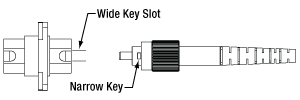
Click to Enlarge
Wide-Key-Slot Mating Sleeve and Narrow Key Connector:
Recommended for Narrow Key FC/PC Connectors
Not Recommended for Narrow Key FC/APC Connectors
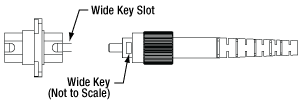
Click to Enlarge
Wide-Key-Slot Mating Sleeve and Wide Key Connector:
Recommended for All Wide Key Connectors
- 2.2 mm Wide-Key-Slot Mating Sleeves
- Designed for All FC/PC-Terminated Fibers
- <0.5 dB Insertion Loss* (Measured at 635 nm with FC/PC-Terminated SM600 Fibers)
Thorlabs' ADAFC2 Wide-Key-Slot Mating Sleeve has a square flange with through holes for custom assemblies or our blank connection panels. The ADAFC1 Wide-Key-Slot Mating Sleeve is designed for the D-hole of a standard rack-mount panel, such as our fiber connection panels. To view a drawing with the recommended mounting hole pattern, click the Docs icon (![]() ) below. These mating sleeves are compatible with either our square-flange or D-hole L-brackets sold below. The ADAFC2 is also available premounted in an L-bracket.
) below. These mating sleeves are compatible with either our square-flange or D-hole L-brackets sold below. The ADAFC2 is also available premounted in an L-bracket.
Flat FC/PC connectors are significantly less alignment sensitive than their angled FC/APC counterparts, making these wide-key-slot mating sleeves acceptable for narrow and wide key FC/PC connectors. Although these mating sleeves are mechanically compatible with narrow key FC/APC connectors, the wide-key slot makes it difficult to properly align the angled, narrow key FC/APC connector. For FC/APC applications, we therefore recommend the narrow-key-slot mating sleeves shown immediately below. All FC/PC and FC/APC patch cables manufactured by Thorlabs use narrow key connectors.
Each mating sleeve includes two protective caps that shield the connectors from dust and other contaminants. These caps should be removed before use. Please note that the size of these caps may vary from lot to lot. The CAPF1 metal cap is also available for use when these mating sleeves are mounted into our L-Brackets, sold below.
*Please Note: When PM fiber is used, the insertion loss will increase to >1.0 dB. For mating PM fiber, we recommend using our PM fiber mating sleeves sold below.

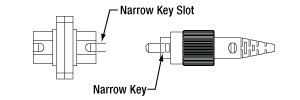
Click to Enlarge
Narrow-Key-Slot Mating Sleeve and Narrow Key Connector:
Recommended for All Narrow Key Connectors
- 2.0 mm Narrow-Key-Slot Mating Sleeves
- Designed for FC/PC- or FC/APC-Terminated Fibers with 2.0 mm Narrow Keys
- <0.5 dB Insertion Loss* (Measured at 635 nm with FC-Terminated SM600 Fibers)
Thorlabs' ADAFC3 Narrow-Key-Slot Mating Sleeve has a square flange with through holes for custom assemblies or our blank connection panels. The ADAFC4 Narrow-Key-Slot Mating Sleeve is designed for the D-hole of a standard rack-mount panel, such as our fiber connection panels. To view a drawing with the recommended mounting hole pattern, click the Docs icon (![]() ) below. These mating sleeves are compatible with either our square-flange or D-hole L-brackets sold below. The ADAFC3 is also available premounted in an L-bracket.
) below. These mating sleeves are compatible with either our square-flange or D-hole L-brackets sold below. The ADAFC3 is also available premounted in an L-bracket.
These narrow-key-slot mating sleeves allow for proper alignment of angled, narrow key FC/APC connectors. These sleeves are also mechanically compatible with narrow key FC/PC connectors, but the flat FC/PC connector is significantly less alignment sensitive, which makes the wide-key-slot mating sleeves shown immediately above an acceptable alternative. All FC/PC and FC/APC patch cables manufactured by Thorlabs use narrow key connectors.
Each mating sleeve includes two protective caps that shield the connectors from dust and other contaminants. These caps should be removed before use. Please note that the size of these caps may vary from lot to lot. The CAPF1 metal cap is also available for use when these mating sleeves are mounted into our L-Brackets, sold below.
*Please Note: When PM fiber is used, the insertion loss will increase to >1.0 dB. For mating PM fiber, we recommend using our PM fiber mating sleeves sold below.


Click to Enlarge
Narrow-Precision-Key-Slot Mating Sleeve
and Narrow Key Connector:
Recommended for Narrow Key PM Fiber Connectors

Click to Enlarge
Wide-Precision-Key-Slot Mating Sleeve and Wide Key Connector:
Recommended for Wide Key PM Fiber Connectors
Not Recommended for Narrow Key PM Fiber Connectors
- Best Possible Matching of Polarization Axes in PM Fibers
- 2.0 mm Narrow Precision Key or 2.2 mm Wide Precision Key FC Connectors
- <1.0 dB Insertion Loss* (Measured at 635 nm with FC/PC- and FC/APC-Terminated PM630-HP Fibers)
Thorlabs' PM Fiber Mating Sleeves have housings made from a single piece of metal, as opposed to the typical two-piece design. This precision construction provides the best possible matching of polarization axes, making them ideal for FC/PC- or FC/APC-terminated PM fibers. To ensure the best performance, choose the mating sleeve that matches your key width. All FC/PC and FC/APC patch cables manufactured by Thorlabs use narrow key connectors.
The ADAFCPM1 and ADAFCPM2 mating sleeves have square flanges with through holes for compatibility for custom assemblies, our blank connection panels, or our square-flange L-brackets (sold below). The ADAFCPM3 Narrow-Key-Slot Mating Sleeve is designed for the D-hole of a standard rack-mount panel, such as our fiber connection panels, and D-hole mounting L-brackets available below. To view a drawing with the recommended mounting hole pattern for each PM mating sleeve, click the Docs icon (![]() ) next to the Item # below. We also offer ADAFCPM1 and ADAFCPM2 mating sleeves premounted in an L-bracket.
) next to the Item # below. We also offer ADAFCPM1 and ADAFCPM2 mating sleeves premounted in an L-bracket.
Each mating sleeve includes two protective caps that shield the connectors from dust and other contaminants. These caps should be removed before use. The CAPF1 metal cap is also available for use when these mating sleeves are mounted into our L-Brackets, sold below.
*Please Note: If using a non-PM fiber this insertion loss will typically be less than 0.5 dB, due to higher tolerancing than our non-PM mating sleeves sold above.

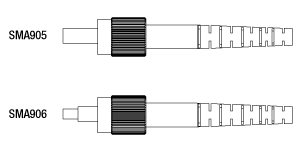
Click to Enlarge
The SMA906-style connector's ferrule has a step, which requires a ceramic alignment sleeve when mating it with an SMA905-style connector.
- Designed for SMA-Terminated Fibers
- <1.5 dB Insertion Loss (Typical Loss for a Pair of Ø200 µm Core Multimode Fibers)
- Sold Individually or in Packs of 10
- Vacuum-Compatible SMA to SMA Mating Sleeve Sold Below
Thorlabs' ADASMA Mating Sleeve is an air-spaced mating sleeve for connecting two SMA-terminated fiber optic cables. It is directly compatible with SMA905-style connectors, and one ceramic alignment sleeve is included for mating an SMA905-style connector to an SMA906-style connector. The ADASMA is not intended for mating an SMA906-style connector to another SMA906-style connector. A washer and nut are included for panel mounting, as well as two dust caps for protecting the exposed ends of the mating sleeve. Our CAPN1 Metal Cap, sold separately, also protects the mating sleeve ends and can clip on to our L-bracket mounts.
These mating sleeves can be purchased individually or in packs of ten (Item # ADASMA-10) at a significant savings over the individual price. Each 10-pack includes ten mating sleeves, ten washers, ten nuts, ten alignment sleeves, and twenty dust caps to protect the exposed ends of the mating sleeves. The ADASMA is also available premounted in an L-bracket.

| Vacuum Compatibility Specifications | |
|---|---|
| Vacuum Compatibility as Packageda | 10-10 Torr |
| Materials | 304 Stainless Steel |
| Preparation and Packaging | Chemically Cleaned and Double Vacuum Bagged |

Click to Enlarge
The ADASMAV has a Ø0.063" (Ø1.6 mm) vent hole.
- Air-Spaced SMA to SMA Mating Sleeve for Ultra-High-Vacuum Applications
- Constructed from 304 Stainless Steel
- <1.5 dB Insertion Loss (Typical Loss for a Pair of Ø200 µm Core Multimode Fibers)
- Double-Bagged for Cleanroom Environments
- Compatible with Thorlabs' Vacuum-Compatible Multimode Fiber Optic Patch Cables
Thorlabs' ADASMAV Mating Sleeve is a vacuum-compatible version of the ADASMA SMA to SMA Mating Sleeve. Constructed using 304 stainless steel, this adapter is designed to be used within ultra-high vacuum systems (>10-10 Torr) and features a Ø0.063" (Ø1.6 mm) vent hole in the side to allow trapped gases to escape (see image to the right). Unlike the standard version, the ADASMAV is only compatible with SMA905-style connectors. A 304 stainless steel washer and nut are included for custom mounting.
Many of our patch cables can be special ordered for vacuum use. Contact Tech Support for details.
Vacuum Compatibility Information
Our vacuum-compatible adapter is chemically cleaned and prepared for vacuum applications before packaging. It is compatible directly out of the packaging with vacuum environments down to 10-10 Torr. With additional cleaning and processing, it can be used at even lower pressures, only limited by the outgassing rate of the stainless steel. The material properties of the stainless steel and the cleaning methods completed by the end user should be used to determine the appropriateness of these products and materials in a specific vacuum system. Please note that using caps or panels not rated for vacuum applications with the ADASMAV is not recommended.
We also offer other vacuum-compatible components which may be used in vacuum applications.


Click to Enlarge
ADALC1 Mating Sleeve Connecting Two Fiber Patch Cables
- Connect Two LC/PC-Terminated Fibers
Thorlabs' ADALC1 Mating Sleeve connects two LC/PC-terminated fiber optic cables, as seen in the image to the right. The sleeve incorporates two tabs that snap into place when inserted into a panel.

- Designed for ST®/PC-Terminated Fibers
- 3/8"-24 UNF-2A Thread
Thorlabs' ADAST Mating Sleeve connects two ST/PC-terminated fiber optic cables. A washer and 3/8"-24 UNF-2A threaded nut are included for panel mounting. Our CAPT1 Metal Cap, sold separately, protects the exposed end of the mating sleeve.
The ADAST is also available premounted in an L-bracket.


Click to Enlarge
ADAE1 Mating Sleeve Connecting Two Fiber Patch Cables
- Connect Two E-2000®*/PC-Terminated Fibers
Thorlabs' ADAE1 Mating Sleeve connects two E-2000/PC-terminated fiber optic cables, as seen in the image to the right. We offer an E2000C3 E-2000/PC Connector to terminate compatible fibers. The sleeve incorporates two flanges, allowing the sleeve to be fastened to a panel with the two included button head M2 x 0.4 screws. Two dust caps are also included to protect the sleeve.
*E-2000® is a registered trademark of Diamond S.A.

- Mate an FC/PC-Terminated Fiber to an SMA-Terminated Fiber
- 2.2 mm Wide-Key-Slot FC/PC Connector
- SMA905-Style SMA Connector
Thorlabs' ADAFCSMA1 Mating Sleeve mates an FC/PC-terminated single mode (SM) or multimode (MM) fiber to an SMA-terminated MM fiber by bringing the tips into physical contact. Our CAPF1 and CAPN1 Metal Caps are designed to protect the FC and SMA ends of the mating sleeve, respectively. Please note that this mating sleeve is only compatible with SMA905-style connectors.
The typical insertion loss for mating an FC/PC-terminated SM fiber to an SMA-terminated MM fiber is less than 0.2 dBa, while the typical insertion loss for mating an FC/PC-terminated MM fiber to an SMA-terminated MM fiber is less than 1.4 dBb.
The ADAFCSMA1 is also available premounted in an L-bracket.

- Mate an FC/PC-Terminated Fiber to an ST®*/PC-Terminated Fiber
- <0.28 dB Insertion Loss (Typical Loss for a Pair of SM Fibers)
Thorlabs' ADAFCST1 Mating Sleeve mates an FC/PC-terminated single mode (SM) or multimode (MM) fiber to an ST/PC-terminated SM or MM fiber by bringing the tips into physical contact. It features a 2.2 mm wide-key-slot FC/PC connector and can be mounted in custom assemblies, our blank connection panels, or our square-flange L-brackets (sold below) for compatibility with 1/4"-20 (M6) mechanical assemblies. To view a drawing with the recommended mounting hole pattern, click the Docs icon
(![]() ) below.
) below.
Our CAPF1 and CAPT1 Metal Caps, sold separately, are designed to protect the FC/PC and ST/PC ends of the mating sleeve, respectively.
*ST® is a registered trademark of Lucent Technologies, Inc.

- Mate an FC/PC-Terminated Fiber to an SC/PC-Terminated Fiber
- <0.11 dB Insertion Loss (Typical Loss for a Pair of SM Fibers)
Thorlabs' ADAFCSC1 Mating Sleeve mates an FC/PC-terminated single mode (SM) or multimode (MM) fiber to an SC/PC-terminated SM or MM fiber by bringing the tips into physical contact. It features a 2.2 mm wide-key-slot FC/PC connector and has a square flange with through holes compatible with our blank connection panels or square-flange L-brackets (sold below). To view a drawing with the recommended mounting hole pattern, click the Docs icon (![]() ) below.
) below.
Our CAPF1 Metal Cap, sold separately, protects the exposed FC/PC end of the mating sleeve.

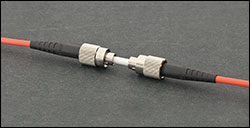
Click to Enlarge
ADAF1 Mating Sleeve Connecting Two Fiber Patch Cables
- Mate Any Fiber with Ø1.25 mm or Ø2.5 mm Ferrules
- Sold Individually or in Packs of 5
Thorlabs Ferrule Mating Sleeves are designed for use with any terminated fiber with a Ø2.5 mm ferrule, such as FC/PC, ST®*/PC, or SC/PC connectors, or with a Ø1.25 mm ferrule, such as LC/PC or MU/PC connectors. These split sleeves can be used to create a temporary, quick-release connection between two cables, as shown in the photo to the right. They are compatible with both ceramic and stainless steel ferrule connectors. They are also compatible with our optogenetics fiber optic cannulae, optogenetics patch cables, and empty ceramic ferrules.
Ceramic mating sleeves are durable and can be easily cleaned in an autoclave. Phosphor bronze mating sleeves are opaque and slightly malleable, offering less light leakage into the environment and a lower disconnection force compared to ceramic sleeves. Phosphor bronze sleeves may also be crimped for a more secure connection. Ceramic sleeves are available individually or in packs of five, while phosphor bronze sleeves come in packs of five.
| Item # Prefix | Compatible Ferrule Size | Insertion Loss | Length | Disconnect Force | Comparison Graphs | Material |
|---|---|---|---|---|---|---|
| ADAL1 | 1.25 mm Outer Diameter | <0.5 dB Typical (SM)a <1.0 dB Typical (MM)b |
6.8 mm | 14.5 N (3.3 lbf) Typicalc | Ceramic (Zirconia) | |
| ADAL4 | 7.1 N (1.6 lbf) Typicalc | Phosphor Bronze | ||||
| ADAF1 | 2.5 mm Outer Diameter | <0.2 dB Typical (SM)d <1.0 dB Typical (MM)e |
11.4 mm | 15.8 N (3.5 lbf) Typicalf | Ceramic (Zirconia) | |
| ADAF4 | 14.4 N (3.2 lbf) Typicalf | Phosphor Bronze |
*ST® is a registered trademark of Lucent Technologies, Inc.

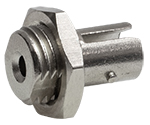
Click to Enlarge
LN3824 Lock Nut Secured to the HAST ST/PC Adapter
- Ideal for OEM or Custom Applications
- 2.0 mm Narrow-Key-Slot FC/PC Bulkhead Adapter
- 2.2 mm Wide-Key-Slot FC/PC Bulkhead Adapter
- SMA905- or SMA906-Style Bulkhead Adapter
- ST/PC Bulkhead Adapter and Compatible 3/8"-24 Lock Nut
- Useful for Fiber-to-Free-Space Interfaces
Thorlabs Bulkhead Adapters each accept a fiber connector on one side and have threads that can be used to mount the adapter into an OEM or custom system. They are useful for applications that require light to be launched from a fiber into a free-space setup. The design aligns the front face of the connector ferrule with the rear surface of the adapter, as shown in the photo to the right, and allows the fiber to be placed in near-physical contact with any optics or instruments that are placed after the adapter.
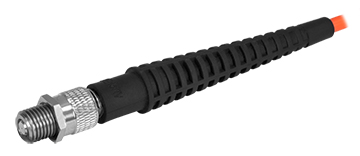
Click to Enlarge
HASMA Adapter Attached to an SMA-Terminated Fiber Patch Cable
For compatibility with FC/PC-terminated patch cables, we offer two bulkhead adapters: the HAFC2 with a 2.0 mm narrow-key slot and the HAFC with a 2.2 mm wide-key slot. Both adapters have 3.2 mm long, 3/8"-24 external mounting threads on the side opposite the FC/PC connector. To create 3/8"-24 taps in custom assemblies, Thorlabs offers the TAP3824 tap.
Our HASMA adapter is 0.38" (9.65 mm) long, with a 1/4"-36 threaded barrel for use with SMA905- and SMA906-style terminated fiber optic patch cables. The threaded barrel can also be used with the lock nut for mounting within OEM or custom systems.
The HAST adapter is a 0.58" (14.8 mm) long adapter for use with ST/PC terminated fiber optic patch cables. It has 0.18" (4.6 mm) of external 3/8"-24 external threads. The LN3824 Lock Nut, which has internal 3/8"-24 threads, may be purchased separately for mounting within OEM or custom systems. Both the HAST adapter and LN3824 are also available in packs of ten.
The uncommon mounting threads in these adapters will require the use of custom mounting solutions. The HAFC2, HAFC, and HASMA adapters may directly screw into an adapter plate. In order to mount the HAST adapter, the LN3824 lock nut must first be threaded onto the adapter (see the photo above). Once the lock nut is secure, the assembly may be threaded onto an adapter plate with a thread depth of at least 0.10" (2.54 mm). Please note that the HAST adapter and LN3824 lock nut are machined so that the maximum amount of torque needed to secure them into the adapter plate should not exceed 121.6 oz-lbs (0.86 N•m).
We recommend engaging at least two threads for stability when using a custom mount, with thread locker (Loctite) as an option for permanent solutions. If tapping a hole is not an option, the adapters can also be epoxied in place.
If a custom or OEM solution is not desired, the adapters are also available mounted within unthreaded and SM-threaded disks (sold above) for compatibility with our lens tube systems. Fiber and bulkhead caps are also available for preventing damage to the terminated fiber when it is not in use. For OEM inquiries, please contact techsales@thorlabs.com.

| Item # | ADABS1 | ADABS2 | ADABS3 | ADABD1 | ADABD2 | ADABD3 |
|---|---|---|---|---|---|---|
| Sleeve Type | Square Flange | D-Hole | ||||
| L-Bracket Type | Single | Dual | Quadruple | Single | Dual | Quadruple |
| Compatible Sleeves | ADAFC2 ADAFC3 ADAFCPM1 ADAFCPM2 ADAFCST1 ADAFCSC1 |
ADAFC1 ADAFC4 ADAFCPM3 |
||||
- Compatible with Either Square Flange or D-Hole FC Mating Sleeves
(See Table to the Right) - Single, Dual, and Quadruple Brackets Available
- Single and Dual Brackets Include One or Two CAPF1 Metal Caps
Thorlabs' Empty L-Brackets are provided for customers who purchase our unmounted FC mating sleeves separately. They allow the construction of L-bracket mating sleeves not offered from stock; for example, a narrow key connector and a wide key connector can be placed into one L-bracket.
These L-brackets contain one or two 1/4" (M6) through holes for easy mounting to a post, optical table, or breadboard. All L-brackets feature 4-40 tap(s) to secure a CAPF1 Metal Cap, available for purchase separately. Single versions include one CAPF1 Metal Cap, while dual versions include two.
The ADABS1, ADABS2, and ADABS3 include screws with 2-56 threading for attaching the square flange mating sleeves. Replacement screws (Item # SH2S019) are available in packs of 50.

Thorlabs' G608N3 Index Matching Gel is a crystal-clear optical coupling compound intended to reduce signal attenuation in wave guide assemblies at connections. The presence of air at the junction of two optical fibers causes significant signal refraction due to the large differential optical impedance that exists between air and the signal-carrying wave guides.
The optical coupling compound G608N3 has been formulated with the requisite optical properties of clarity, purity, and refractive index to minimize signal losses while allowing pliable mechanical connections between rigid parts. Unlike a rigid optical epoxy, this pliable gel is viscoelastic and can take up the differential thermal expansion of precision optical parts without inducing excessive stresses or delamination. Residue may be cleaned from fiber tips using methanol or isopropyl alcohol.
In many devices, these materials serve an additional function: they help seal out ambient dust or fluids from sensitive optical components. This gel is formulated to be ultraclean, non-yellowing, and unaffected by x-ray, ultraviolet or sunlight exposure. It has extremely low outgassing and volatility characteristics and is free from light-absorbing microscopic particulates. This optical product is a chemically stable, non-toxic, synthetic material with wide temperature serviceability and is suitable for designs with high reliability and long service life.
The table below gives data on the decrease in signal loss when using the gel. Each syringe comes with 3 cc of index matching gel. This index matching gel can also be used to refill our fiber-to-fiber splice kits.
| Insertion Loss Improvement | |||
|---|---|---|---|
| Connector Types | Loss Without Index Matching Gel G608N3 | Loss With Index Matching Gel G608N3 | Difference |
| SMA-to-SMAa | 2.88 dB | 1.25 dB | 1.63 dB |
| FC/PC-to-FC/PCb | 1.12 dB | 0.59 dB | 0.53 dB |
 Products Home
Products Home













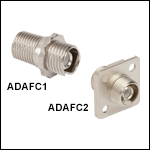
 Zoom
Zoom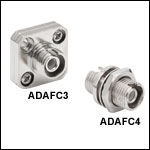
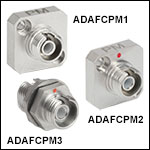
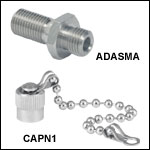
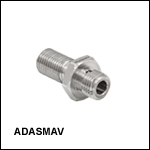
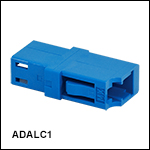
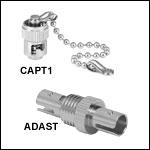

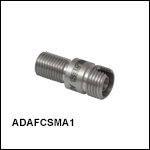
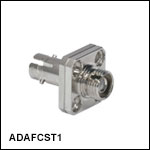
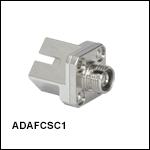

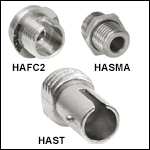
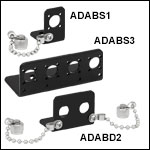
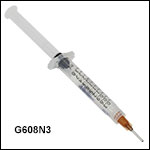
 Mating Sleeves
Mating Sleeves